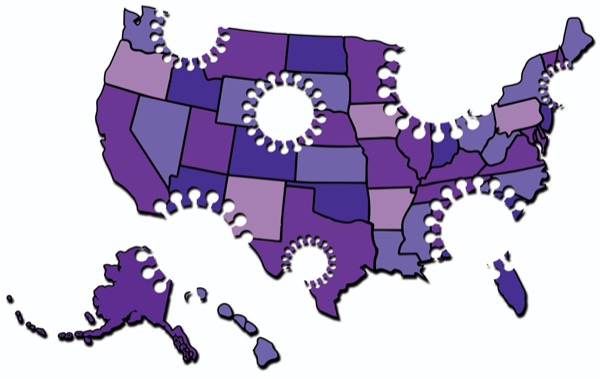More than 2 million people in the United States have hepatitis C virus, and most of them have not received the direct-acting antivirals that can cure more than 95% of these infections, according to a new report by the CDC.
The new CDC study indicates “jarringly low numbers” of people with known HCV infection are being cured, said researcher Carolyn Wester, MD, MPH, the director of the CDC’s Division of Viral Hepatitis (MMWR Morb Mortal Wkly Rep 2023;72(26):716–720).
“Thousands of people are dying every year in our country and many more are suffering from an infection that has been curable for over 10 years,” since the DAAs were developed, according to Jonathan Mermin, MD, MPH, the director of the CDC’s National Center for HIV, Viral Hepatitis, STD, and TB Prevention. “Only one-third of people diagnosed with hepatitis C have been cured,” Dr. Mermin said at a CDC media briefing. In addition, he said up to 1 million Americans could be undiagnosed.
Dr. Mermin put the abysmal statistic clearly at the feet of third-party payors. “This is mostly because insurers have placed obstacles in the way of people and their doctors, preventing patients from accessing treatment. It is time we remove these barriers and expanded public health systems to prevent new infections.”
The CDC study used data from commercial laboratories on more than 1 million people nationwide who were diagnosed with HCV between 2013 and 2022, when several DAAs were available, according to Dr. Wester.
The data indicate that the proportions of people cured were:
- low overall and across all age and insurance groups analyzed;
- lowest among people without health insurance or with Medicaid coverage, as well as adults younger than 40 years—a group that has the highest rates of new HCV infections; and
- highest among people 60 years and older with Medicare or commercial insurance (still less than half had been cured).
“Overall, only one in three people diagnosed with hepatitis C were cured, and only one in six adults under the age of 40 without health coverage were cured,” Dr. Wester said.
Although there are many reasons for the lack of uptake of DAAs, Dr. Webster highlighted two: One, because of the high cost of treatment, some payors limit eligibility for treatment or require burdensome prior authorization before treatment can begin, or even limit the types of providers who can prescribe treatment. “All of these restrictions can delay or even prohibit access to these lifesaving medications,” she said. Two, hepatitis C is a silent killer. The CDC estimates about 40% of people with HCV are unaware of their infection.
“So, while this study looks at treatment gaps among people with diagnosed hepatitis C, there is also a great need to increase screening and testing for hepatitis C. The CDC recommends that everyone be tested for hepatitis C at least once in their lifetime,” Dr. Wester said.
Francis S. Collins, MD, PhD, of the National Institutes of Health also commented on the need for more testing to find asymptomatic infections. Testing can be cumbersome because an antibody test and then an RNA test are needed, and both must be sent to a laboratory for the results. “There can be a long delay, and we lose a lot of people along the way,” Dr. Collins said. The NIH and FDA are working on clearance of a test that could give results in an hour or less.
There is an urgent need to act boldly, stressed Dr. Collins, who discussed a proposed National Hepatitis C Elimination Program, which is seeking support from Congress to eliminate HCV in the United States with more widespread use of DAAs.
“The CDC report ... highlights an urgent need for a bold response to hepatitis C. And the cure that’s been available now for 10 years is very simple: one pill a day for eight to 12 weeks, very limited side effects,” as opposed to previous more toxic interferon treatment, which was not very effective, Dr. Collins said.
Because Medicare copays can run as high as $4,000, cost can still be an obstacle, even if it is covered and approved, Dr. Collins said. So, the new program would create an innovative model, called a subscription model, to deal with the cost.
Successful Pilot Program
The program was successfully piloted in Louisiana. The state worked with Gilead and AbbVie, paying a lump sum to make the drug available for free to Medicaid patients and federal prisoners. The arrangement was successful in getting more people on DAAs, Dr. Collins said.
The proposal on the table is to do the same on a national level to ensure that underserved individuals have access to these lifesaving treatments, he said.
Although the National Hepatitis C Elimination Program would be expensive, it would be offset by the number of lives saved and expensive treatments such as liver transplants avoided, according to Dr. Collins. In the long run, the program is estimated to save the government more than $13 billion in 10 years.
“It’s rare, in my experience, to have an opportunity to both save lives and save money,” Dr. Collins said. “How often do we have the chance to eliminate a terrible disease that has already taken way too many lives and to do so with a simple oral therapy that has very few side effects? We have an opportunity to do something truly historic.”
—Marie Rosenthal
This article is from the August 2023 print issue.





